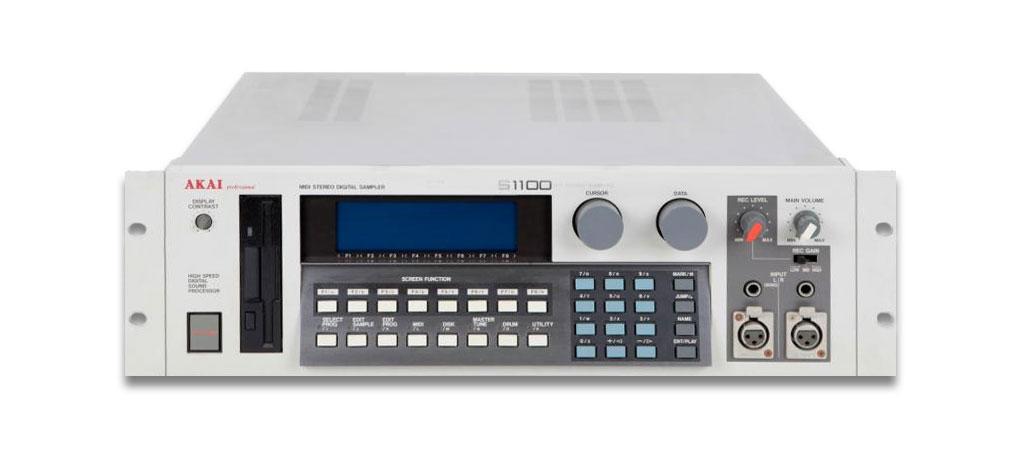AKAI S1100 - The Legendary Sampler That Defined Hip-Hop and Electronic Music

The Akai S1100 is one of the most influential samplers of its time. Released in 1990, it introduced 16-bit sampling at CD quality, advanced editing capabilities, and expandable memory, making it a key instruments in studios and live performances. With its pristine sound, powerful effects processor, and SCSI interface, this sampler became a favorite among electronic musicians and film composers.
History and Development of Akai S1100
Origins of Sampling and the Akai S Series
Akai Professional was a pioneer of digital sampling since the 1980s. After the success of models like the S900 and S1000, the Akai S1100 was released, setting a new standard for professional production.
Its key improvements included:
• Higher sound quality with 16-bit sampling.
• Expanded memory, with the ability to upgrade up to 32MB RAM.
• Fast connectivity via SCSI port for external drives.
• More advanced effects processor, supporting stereo reverb, chorus, and delay.
These features made it an indispensable tool for film composers, hip-hop producers, and electronic musicians.
Audio Formats Supported by Akai S1100
The Akai S1100 uses native Akai sampling formats but also supports additional file types:
• Akai S1000/S1100 format – Full compatibility with previous models.
• WAV (via conversion) – Import capability via external software.
• AIFF (via conversion) – Supported through SCSI connections.
• SND (Sound Designer II) – Used in early digital studios.
Being able to load older Akai disks allows for seamless transfer of sound libraries between different generations of Akai samplers.
Detailed Overview of the Akai S1100 Display
The Akai S1100 features a large LCD screen, providing clear sample editing functions.
The display includes the following information:
Main Screen
• Current program name – Identifies the loaded sample.
• Polyphony count – Displays the number of voices in use.
• Memory usage – Shows available RAM.
Sample Editing Screen
• Waveform editor – Graphically displays the sample.
• Start/End points – Defines the sample’s beginning and end.
• Looping options – Allows loop adjustments.
Effects Section
• Reverb, chorus, delay – Adjustable effects settings.
• Filter and EQ – Frequency modification controls.
The display simplifies sample editing, making it more intuitive for users, which was a major innovation at the time of release.
Rear Panel of Akai S1100 – Inputs and Outputs
The Akai S-1100 includes a range of inputs and outputs for flexible integration into studio setups.
Audio Inputs
• Stereo input (L/R) – For sampling recordings.
• Microphone inputs (XLR) – Supports direct recording.
Audio Outputs
• Stereo main output (L/R) – Primary mixed output.
• 8 individual outputs – Enables separate channels for flexible mixing.
• Effects send/return – Supports external effects processing.
Digital Outputs
• AES/EBU digital output – Professional-grade digital connectivity.
• SPDIF output – Enables direct connections to mixing consoles.
MIDI Connectivity
MIDI IN, OUT, THRU – Full integration within studio setups.
Working with Loops on Akai S1100
1. Selecting a Sample – First, load or record the sample that will be used for looping.
2. Setting Loop Points – Use the display to define start and end points for the loop with Loop
LoopStart and Loop End settings.
3. Types of Loops – The Akai S1100 offers several looping modes:
• Forward Loop – Plays from the start to the end, then restarts.
• Reverse Loop – Plays from the end to the start, then restarts.
• Alternating Loop – Plays forward and then backward for smoother transitions.
4. Fine-Tuning the Loop – With the Crossfade Looping function there is possible to eliminate unwanted clicks when looping between the start and end points.
Akai S1100: Filters and Their Unique Sound
The Akai S1100 features digital low-pass filters, allowing for precise sound shaping and removal of unwanted high frequencies.
Low-Pass Filter (LPF)
• Removes high frequencies, preserving low-end warmth.
• Adjustable cutoff frequency for fine-tuning.
• Used for: Deep basses, warm pads, smooth textures.
Resonant Low-Pass Filter
• Boosts frequencies around the cutoff point, creating a ringing effect.
• Self-oscillation possible at high resonance settings.
• Used for: Sharp synth leads, acid sounds, and modulated effects.
Digital Filter with EQ
• Fine-tune frequencies with a parametric equalizer.
• Used for: Adjusting samples with precision, removing unwanted noise.
Comparison Between Akai S1100 and Modern Software Samplers
Advantages of Akai S1100
• Authentic hardware sound with distinct analog-digital characteristics.
• Low latency, providing immediate response.
• Hands-on control, enabling direct manipulation of sample parameters.
Advantages of Software Samplers
• Unlimited effects processing due to advanced DSP engines.
• Flexible modulation options, surpassing hardware limitations.
• Seamless DAW integration for modern workflows.
Despite modern innovations, the Akai S1100 remains unique, offering a timeless sound that software samplers attempt to emulate but never fully replicate.
Musicians Who Used the Akai S1100:
Electronic Music
• Jean-Michel Jarre
• Depeche Mode
• Pet Shop Boys
• The Chemical Brothers
• Orbital
• The Prodigy
• Gary Numan
• Future Sound of London
• Boards of Canada
• etc.
Hip-Hop
• Dr. Dre
• Pete Rock
• RZA (Wu-Tang Clan)
• DJ Premier
Film Score Production
• Hans Zimmer
• Trent Reznor (Nine Inch Nails)
Conclusion
The Akai S1100 was a revolutionary sampler that shaped the music production of the 1990s. With powerful filtering capabilities, an advanced effects processor, high-quality sampling, and extensive hardware expansion, it became an essential tool for both music producers and composers.
Thanks to its digital output support, intuitive filter control, and distinctive sonic character, the Akai S1100 retains its legendary status among classic sampling enthusiasts even today.
| |
|
|
|
|
|
|
|
|


